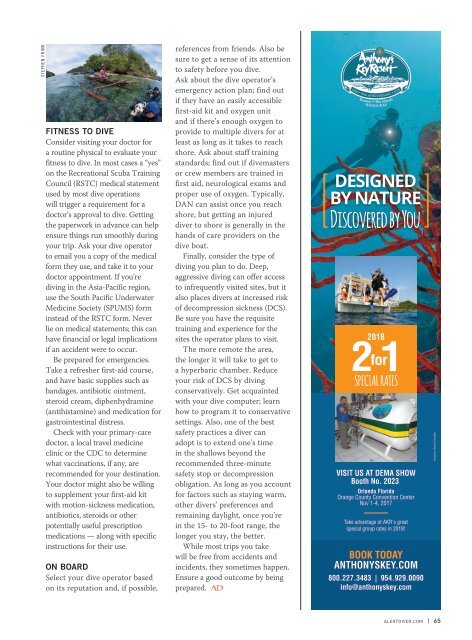AD 2017 Q4
Alert Diver is the dive industry’s leading publication. Featuring DAN’s core content of dive safety, research, education and medical information, each issue is a must-read reference, archived and shared by passionate scuba enthusiasts. In addition, Alert Diver showcases fascinating dive destinations and marine environmental topics through images from the world’s greatest underwater photographers and stories from the most experienced and eloquent dive journalists in the business.
Alert Diver is the dive industry’s leading publication. Featuring DAN’s core content of dive safety, research, education and medical information, each issue is a must-read reference, archived and shared by passionate scuba enthusiasts. In addition, Alert Diver showcases fascinating dive destinations and marine environmental topics through images from the world’s greatest underwater photographers and stories from the most experienced and eloquent dive journalists in the business.
You also want an ePaper? Increase the reach of your titles
YUMPU automatically turns print PDFs into web optimized ePapers that Google loves.
STEPHEN FRINK<br />
FITNESS TO DIVE<br />
Consider visiting your doctor for<br />
a routine physical to evaluate your<br />
fitness to dive. In most cases a “yes”<br />
on the Recreational Scuba Training<br />
Council (RSTC) medical statement<br />
used by most dive operations<br />
will trigger a requirement for a<br />
doctor’s approval to dive. Getting<br />
the paperwork in advance can help<br />
ensure things run smoothly during<br />
your trip. Ask your dive operator<br />
to email you a copy of the medical<br />
form they use, and take it to your<br />
doctor appointment. If you’re<br />
diving in the Asia-Pacific region,<br />
use the South Pacific Underwater<br />
Medicine Society (SPUMS) form<br />
instead of the RSTC form. Never<br />
lie on medical statements; this can<br />
have financial or legal implications<br />
if an accident were to occur.<br />
Be prepared for emergencies.<br />
Take a refresher first-aid course,<br />
and have basic supplies such as<br />
bandages, antibiotic ointment,<br />
steroid cream, diphenhydramine<br />
(antihistamine) and medication for<br />
gastrointestinal distress.<br />
Check with your primary-care<br />
doctor, a local travel medicine<br />
clinic or the CDC to determine<br />
what vaccinations, if any, are<br />
recommended for your destination.<br />
Your doctor might also be willing<br />
to supplement your first-aid kit<br />
with motion-sickness medication,<br />
antibiotics, steroids or other<br />
potentially useful prescription<br />
medications — along with specific<br />
instructions for their use.<br />
ON BOARD<br />
Select your dive operator based<br />
on its reputation and, if possible,<br />
references from friends. Also be<br />
sure to get a sense of its attention<br />
to safety before you dive.<br />
Ask about the dive operator’s<br />
emergency action plan; find out<br />
if they have an easily accessible<br />
first-aid kit and oxygen unit<br />
and if there’s enough oxygen to<br />
provide to multiple divers for at<br />
least as long as it takes to reach<br />
shore. Ask about staff training<br />
standards; find out if divemasters<br />
or crew members are trained in<br />
first aid, neurological exams and<br />
proper use of oxygen. Typically,<br />
DAN can assist once you reach<br />
shore, but getting an injured<br />
diver to shore is generally in the<br />
hands of care providers on the<br />
dive boat.<br />
Finally, consider the type of<br />
diving you plan to do. Deep,<br />
aggressive diving can offer access<br />
to infrequently visited sites, but it<br />
also places divers at increased risk<br />
of decompression sickness (DCS).<br />
Be sure you have the requisite<br />
training and experience for the<br />
sites the operator plans to visit.<br />
The more remote the area,<br />
the longer it will take to get to<br />
a hyperbaric chamber. Reduce<br />
your risk of DCS by diving<br />
conservatively. Get acquainted<br />
with your dive computer; learn<br />
how to program it to conservative<br />
settings. Also, one of the best<br />
safety practices a diver can<br />
adopt is to extend one’s time<br />
in the shallows beyond the<br />
recommended three-minute<br />
safety stop or decompression<br />
obligation. As long as you account<br />
for factors such as staying warm,<br />
other divers’ preferences and<br />
remaining daylight, once you’re<br />
in the 15- to 20-foot range, the<br />
longer you stay, the better.<br />
While most trips you take<br />
will be free from accidents and<br />
incidents, they sometimes happen.<br />
Ensure a good outcome by being<br />
prepared. <strong>AD</strong><br />
DESIGNED<br />
BY NATURE<br />
Discovered by You<br />
2018<br />
2 for 1<br />
SPECIAL RATES<br />
VISIT US AT DEMA SHOW<br />
Booth No. 2023<br />
Orlando Florida<br />
Orange County Convention Center<br />
Nov 1-4, <strong>2017</strong><br />
Take advantage of AKR's great<br />
special group rates in 2018!<br />
BOOK TODAY<br />
ANTHONYSKEY.COM<br />
800.227.3483 | 954.929.0090<br />
info@anthonyskey.com<br />
Image by: Ramiro Gonzáles<br />
ALERTDIVER.COM | 65









